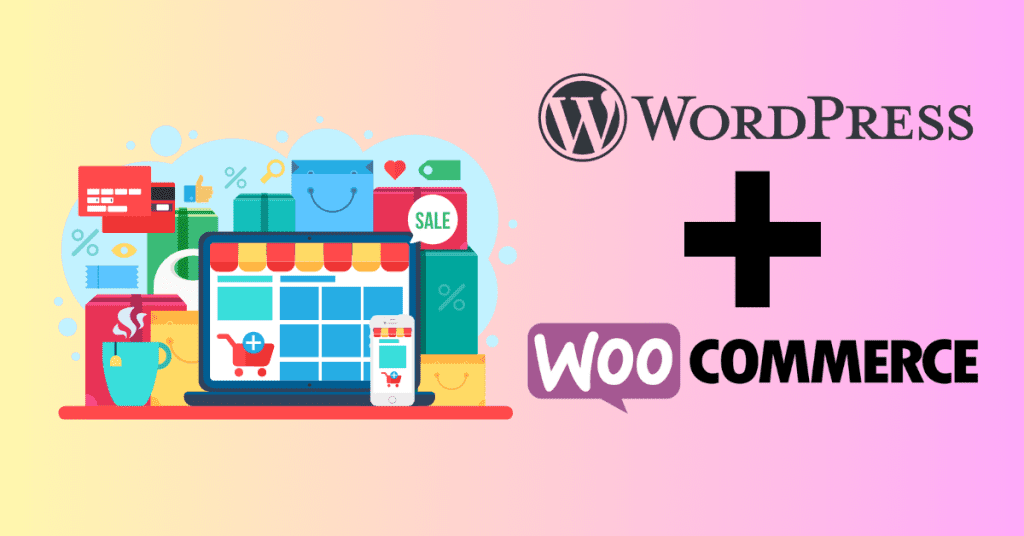In the ever-evolving landscape of the digital world, establishing an online presence is no longer an option—it’s a necessity. Whether you’re a budding entrepreneur, a passionate blogger, or a small business owner, having a website opens doors to a global audience. Creating a WordPress website on Bluehost is not just a technical endeavour.
It’s a gateway to expressing your ideas, showcasing your products, or sharing your stories with the world. In this guide, we’ll navigate the exciting terrain of website creation, focusing on one of the most reliable and user-friendly platforms available: WordPress. To kickstart this journey, we’ll leverage the robust hosting services of Bluehost—a trusted ally for countless website owners.
In the following sections, we’ll be breaking down the process into manageable steps that even a beginner can handle. From choosing the perfect domain to customizing your site and beyond, this guide aims to be your compass as you embark on the exciting adventure of building and managing your very own WordPress website.
Identify Your WordPress Website Goals

Identifying website goals is a crucial step in developing a successful online presence and ensuring that your website serves its intended purpose. First and foremost, it’s essential to clearly define the primary objective of your website.
This overarching goal could be anything from selling products and services, generating leads, providing information, or fostering community engagement. Understanding this fundamental purpose will guide the entire website development process and help you tailor the site to meet specific needs.
Next, consider the target audience for your website. You need to identify your audience and align your goals with the needs and expectations of your visitors. Conduct thorough market research to understand the demographics, preferences, and behaviours of your potential users. By doing so, you can tailor your website goals to better serve the interests and requirements of your audience, ultimately enhancing the user experience and increasing the likelihood of goal attainment.
Measurable objectives are another critical aspect of identifying website goals. Setting specific, measurable, achievable, relevant, and time-bound (SMART) goals provides a clear framework for success. For instance, if the goal is to increase online sales, a measurable objective could be to achieve a certain percentage growth in monthly transactions. Regularly tracking and analyzing key performance indicators (KPIs) will allow you to assess progress, make data-driven decisions, and refine your goals as needed.
Lastly, continuous monitoring and adaptation are essential for maintaining the relevance and effectiveness of your website goals. The online landscape is dynamic, and user preferences may change over time. Regularly review and reassess your website goals, taking into account shifts in market trends, technological advancements, and user feedback. This ongoing process ensures that your website remains aligned with your overall business objectives and continues to meet the evolving needs of your audience.
Key benefits of using WordPress Website CMS
WordPress stands out as one of the most popular and versatile platforms for website creation, offering a myriad of benefits that contribute to its widespread adoption. First and foremost, WordPress is known for its user-friendly interface, making it accessible to both beginners and experienced developers. With a vast library of pre-designed themes and a straightforward content management system (CMS), users can easily create and manage their websites without the need for extensive coding knowledge.
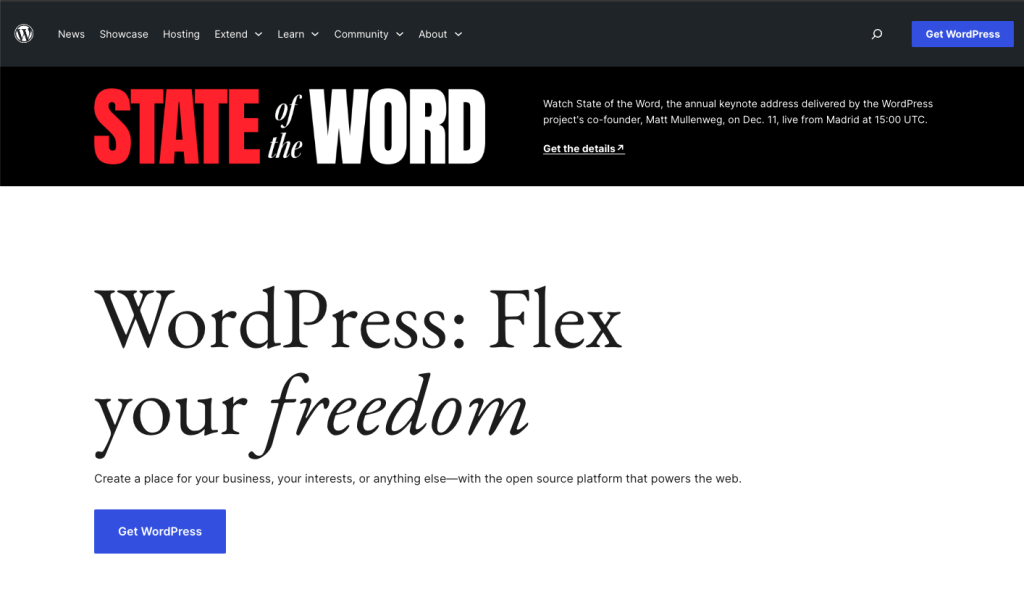
This user-friendly approach significantly reduces the learning curve associated with web development, allowing individuals and businesses to establish an online presence efficiently.
Another key benefit of using WordPress is its extensive plugin ecosystem. WordPress plugins are additional pieces of software that enhance and extend the functionality of your website. Whether you need to optimize for search engines, add e-commerce capabilities, integrate social media, or enhance security, there is likely a plugin available to meet your specific needs.
The flexibility provided by these plugins allows users to customize their websites according to their unique requirements, ensuring scalability and adaptability as the website grows and evolves.
Furthermore, WordPress is an open-source platform, meaning its source code is freely available to the public. This open nature fosters a vibrant community of developers who continually contribute to its improvement and development.
Regular updates and security patches are released, enhancing the platform’s stability and ensuring that websites built on WordPress remain secure. The open-source nature also means that users have the freedom to modify and distribute the software, offering unparalleled control over the design and functionality of their websites. This combination of user-friendly design, extensive plugin support, and an open-source community makes WordPress a powerful and adaptable platform for a wide range of website creation needs.
Choose a Domain
Choosing a domain and hosting provider is a critical decision that lays the foundation for your online presence. When selecting a domain, start by brainstorming a name that is memorable, relevant to your brand or content, and easy to spell. It’s essential to choose a domain that reflects the identity of your website and is easy for visitors to recall.

Additionally, consider the extension (e.g., .com, .net, .org) based on the nature of your website and the geographic location of your target audience. While .com is widely recognized and often preferred, other extensions may be more suitable for specific purposes.
You may get some inspiration by using a domain name generator. But you will need to have a few alternatives if the TLD you want is not available. A TLD is a domain extension. In other words, it’s what follows the “dot” after the end of a web address. The standard TLDs are .com, .org, or .net. But you can also consider creative TLDs like .me, .io, .xyz, .bio., and .blog.
Choose a Hosting Provider
When it comes to selecting a hosting provider, various factors should influence your decision. Assess your website’s requirements, such as the expected traffic volume, storage needs, and technical specifications. Different hosting providers offer various plans, including shared hosting, virtual private servers (VPS), and dedicated servers.
Shared hosting is cost-effective but may lead to slower performance during traffic spikes, while dedicated servers provide maximum control and performance but come at a higher cost. Evaluate the provider’s reliability, uptime guarantees, and customer support. Reading reviews and seeking recommendations can provide insights into the reputation and service quality of different hosting companies.

Consider the scalability options offered by the hosting provider. As your website grows, you may need to upgrade your hosting plan or even switch providers. Ensure that the provider allows for seamless scalability to accommodate your expanding needs. Additionally, assess the security features provided, including SSL certificates, regular backups, and other measures to protect your website and its data. A robust hosting infrastructure is crucial for the overall performance, reliability, and security of your website, making it essential to choose a provider that aligns with your specific requirements and long-term goals.
Tips for Choosing a WordPress Website Hosting Plan
Selecting the right website hosting plan is an important decision that directly impacts the performance, reliability, and scalability of your online presence. Firstly, carefully assess the specific needs of your website. Different hosting plans cater to varying requirements, and understanding the nature of your site is crucial. If you’re launching a small blog or personal website, shared hosting may be a cost-effective choice. For larger websites with higher traffic or e-commerce functionalities, a virtual private server (VPS) or dedicated server might be more suitable. Matching your hosting plan to the scale and complexity of your website ensures optimal performance and resource allocation.

Consider the level of technical support provided by the hosting provider. Reliable customer support is essential, especially if you encounter issues or need assistance with configurations. You need to evaluate the provider’s support channels, response times, and overall customer satisfaction ratings. Many reputable hosting companies offer 24/7 support through various means such as live chat, email, and phone. This will ensure that help is available whenever you need it. Thoroughly researching and understanding the support services can prevent potential headaches and downtime in the future.

Furthermore, scrutinize the hosting provider’s reliability and uptime guarantees. A hosting plan with high uptime ensures that your website remains accessible to visitors consistently. Look for hosting providers that offer at least a 99.9% uptime guarantee. Additionally, read customer reviews and testimonials to gauge the actual experiences of other users with the hosting provider. Reliability is paramount, and a hosting plan that consistently delivers on uptime commitments contributes to a positive user experience and fosters trust in your online brand.
Get started with Bluehost WordPress Hosting – Limited Time Offer Available
Installing WordPress Website with Bluehost
Installing WordPress with Bluehost is a straightforward process, thanks to Bluehost’s user-friendly interface and one-click installation feature.
To begin, first, sign up for a Bluehost account and choose a hosting plan that suits your needs. Once you’ve completed the registration process, log in to your Bluehost account and navigate to the control panel, also known as the cPanel. Inside the cPanel, you’ll find the “Website” section, where you can click on the “Install WordPress” icon.
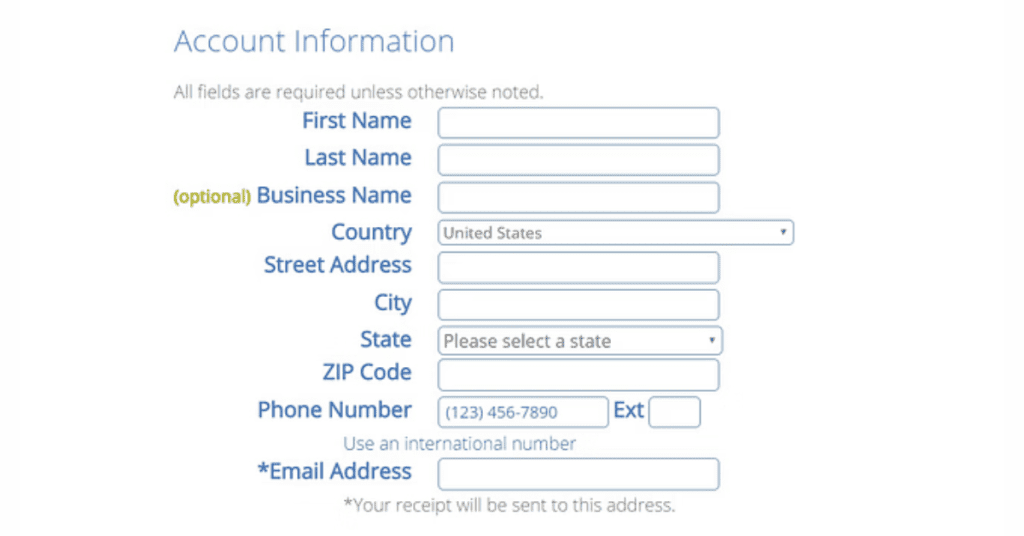
After clicking on the “Install WordPress” icon, Bluehost will guide you through the setup process. You’ll be prompted to select the domain on which you want to install WordPress. If you’ve just registered a domain with Bluehost, it will appear in the drop-down menu.
Choose your domain and click “Next.” On the next screen, you can customize your website settings, such as your site title, username, and password. You can also choose to install essential plugins and select a theme. Once you’ve configured these settings, click on the “Install” button, and Bluehost will take care of the rest.

Once the installation is complete, you’ll receive a confirmation, and you can log in to your new WordPress site. Bluehost simplifies the process of installing WordPress, making it accessible even for those without extensive technical knowledge. The one-click installation feature streamlines the setup, allowing you to focus on creating and customizing your WordPress website.
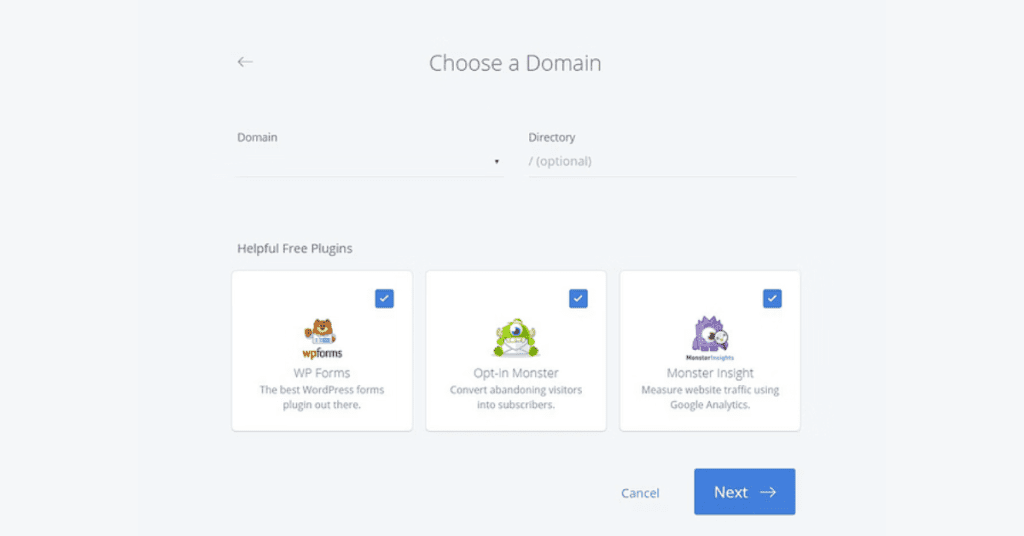
Choosing A WordPress Website Theme
Choosing the right WordPress theme is a critical decision that directly impacts the overall aesthetics, functionality, and user experience of your website. Begin by identifying the purpose and goals of your website. Whether you’re creating a blog, portfolio, business site, or e-commerce platform, understanding your specific needs will guide you in selecting a theme that aligns with your objectives.
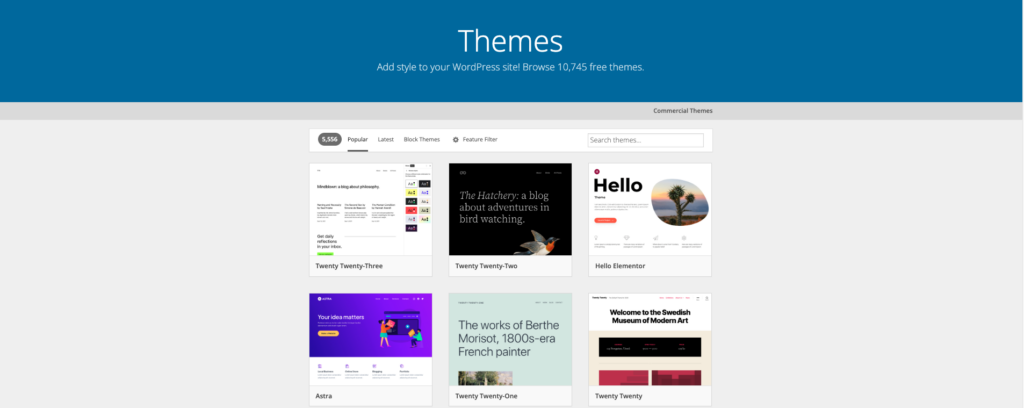
You will also need to consider the features required, such as responsive design, customizable layouts, support for multimedia content, and compatibility with essential plugins. A theme that complements your content and provides the necessary features for your website type will contribute to its success.
Next, evaluate the design and visual appeal of potential themes. A well-designed theme enhances the professionalism and credibility of your website. You should look for clean and modern designs that are visually appealing and align with your brand identity. You can pay attention to colour schemes, typography, and overall layout to ensure a cohesive and engaging visual experience for your visitors.
Additionally, consider the theme’s customization options. A theme with robust customization capabilities allows you to tailor the appearance of your website to suit your preferences without requiring advanced coding skills.
Finally, you should prioritize themes with good performance and speed. These themes have been proven to work well and optimized for best performance. Website loading times impact user satisfaction and search engine rankings significantly. Hence, you should opt for themes that are optimized for speed and performance.
You can do this by reading user reviews, checking the theme’s documentation, and, if possible, testing its demo to gauge its loading speed. A well-optimized theme contributes to a smoother user experience and is crucial for the long-term success of your website.
How to install a WordPress Theme in WP admin
WordPress offers a vast array of themes, ranging from free options available in the official WordPress Theme Directory to premium themes from third-party providers.
To install a WordPress theme, begin by logging in to your WordPress dashboard. From the admin menu, navigate to “Appearance” and then click on “Themes.” Here, you’ll find the “Add New” button, which takes you to the WordPress Theme Directory.

In the WordPress Theme Directory, you can browse and search for themes based on various criteria such as features, layout, and popularity. Once you find a theme that suits your needs, hover over it, click on “Install,” and WordPress will install the theme automatically.
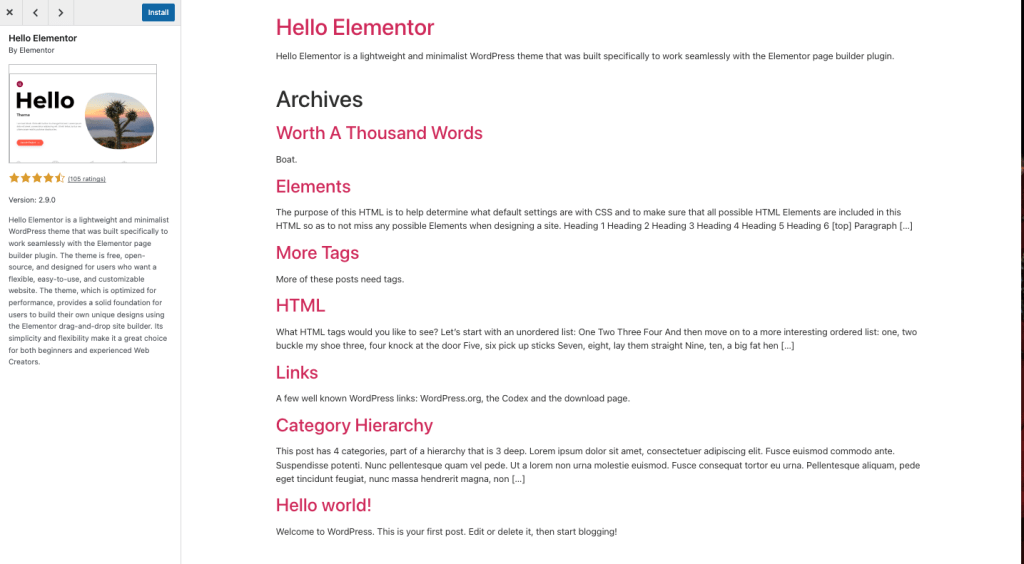
If you have a premium theme from a third-party provider, you can upload it manually. Click on the “Upload Theme” button, choose the theme’s ZIP file from your computer, and click “Install Now.”
Once the theme is installed and activated, you can customize its settings to fit your preferences. Navigate to “Appearance” and then “Customize” from the WordPress dashboard. Here, you can modify various aspects of the theme, including colours, fonts, layout, and more.
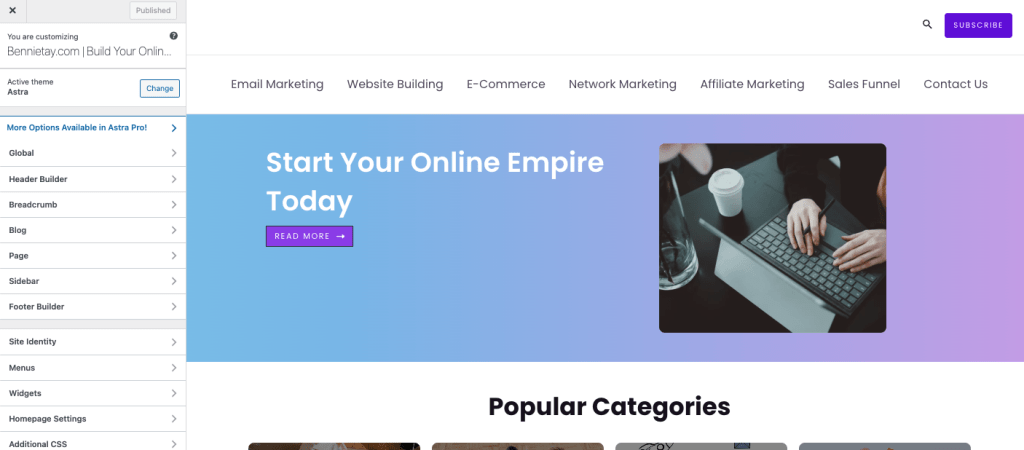
Some themes may come with additional customization options or settings specific to that theme. Explore these options to tailor the appearance of your website to your liking. Remember to preview changes before saving to ensure they look as expected on your live site.
Lastly, it’s essential to regularly update your chosen theme to benefit from new features, security patches, and improvements. From the “Themes” section in the WordPress dashboard, you’ll be notified of available updates, and you can easily apply them with a click. Regular updates help maintain the performance and security of your WordPress theme, ensuring a smooth and reliable user experience for your website visitors.
Customize your WordPress Website
Customizing your WordPress website is important in creating a distinctive and user-friendly online presence. To ensure a seamless and effective customization process, it’s crucial to adhere to the best web design practices.
Responsive and Mobile-friendly
Firstly, begin by choosing a responsive and mobile-friendly theme. You need to choose a responsive design that ensures your website adapts to various screen sizes. This can provide an optimal viewing experience for users on desktops, tablets, and smartphones. This not only enhances user satisfaction but is also a key factor in search engine rankings. Many modern WordPress themes come with built-in responsiveness, so selecting a theme with this feature simplifies the customization process.
Clean and Intuitive Navigation Structure
Next, focus on creating a clean and intuitive navigation structure. The navigation menu is a critical component that guides users through your website. You should use descriptive menu items, organize them logically, and consider implementing drop-down menus for subpages or categories. Avoid clutter and prioritize simplicity to enhance user navigation. Consistent branding elements, such as a recognizable logo, coherent colour scheme, and consistent typography, contribute to a professional and cohesive design. These elements reinforce your brand identity and make your website visually appealing.
Implementing Whitespace
Then, implementing whitespace strategically is another important web design practice. Whitespace, or negative space, provides visual breathing room between elements and enhances readability. Avoid overcrowding your pages with too much content or visual elements. You should embrace a balance between text, images, and whitespace to create a visually pleasing layout. Whitespace also helps direct the user’s focus to essential elements and calls to action.
Font Choices and Typography
Besides, you should be mindful of font choices and typography. You need to select readable fonts and maintain a consistent font style throughout your website. Also, aim for a hierarchy in font sizes to emphasize important information and create a visually harmonious design.
Finally, consider the accessibility of your WordPress website during the customization process. Accessibility involves making your site usable for individuals with disabilities. You need to ensure that your chosen theme and customization choices adhere to accessibility standards, such as providing alternative text for images, using proper heading structures, and creating readable content. This not only broadens your audience but also aligns with ethical and inclusive web design practices.
Creating and Managing WordPress Website Content
Creating and managing website content is a continuous and vital aspect of maintaining a successful WordPress website. Start by developing a content strategy that aligns with your overall goals. You need to define your target audience, identify key topics, and establish a consistent publishing schedule.

The block editor allows you to incorporate various content elements, such as text, images, videos, and embeds, flexibly and intuitively. Organize your content into categories and tags to enhance navigation and improve the overall user experience. By having a well-defined content strategy, you can provide valuable information to your audience and establish a cohesive and compelling online presence.
Regularly update and optimize your existing content to keep it relevant and appealing. This involves reviewing and refreshing older posts, updating information, and ensuring that links and media are still functional.
Additionally, pay attention to on-page SEO practices by optimizing your content for relevant keywords, creating descriptive meta tags, and incorporating internal and external links. These optimizations enhance your content’s discoverability and contribute to a more effective SEO strategy.
Besides, you should encourage audience engagement by incorporating interactive elements in your content. This may include calls-to-action (CTAs), comments sections, social media sharing buttons, and user polls or surveys. Respond to comments promptly and foster a sense of community around your content. Utilize plugins that enhance social sharing and engagement to extend the reach of your content beyond your website.
Finally, implement a robust content management system (CMS) strategy. Organize your content using categories and tags to create a logical structure. Leverage the power of WordPress plugins to enhance content management capabilities. Plugins such as Yoast SEO can assist with optimizing your content for search engines, while others like Akismet help filter out spam comments.
Extending WordPress Website Functionality with plugins
Extending website functionality with plugins is a key strategy in enhancing the capabilities of your WordPress site. Begin by identifying specific features or functionalities that are not native to your theme or core WordPress installation.

Common plugin categories include SEO optimization, security, e-commerce, contact forms, and social media integration. Visit the WordPress Plugin Directory or explore reputable third-party plugin marketplaces to find plugins that align with your website’s needs. Always choose well-reviewed and regularly updated plugins to ensure compatibility with the latest WordPress version and to minimize potential security risks.
When selecting and installing plugins, it’s important to prioritize quality over quantity. Too many plugins can slow down your website and lead to compatibility issues. Carefully read plugin descriptions, reviews, and ratings to gauge the user experience and functionality of each plugin. Only install plugins that are actively supported by developers and have a proven track record of reliability. Additionally, consider the reputation of the plugin developer and the level of community support. A thriving community indicates ongoing development and provides a valuable resource for troubleshooting and assistance.
How to Install WordPress Plugins
To install plugins on your WordPress website, log in to your WordPress dashboard and navigate to the “Plugins” section. Click on “Add New,” where you can search for plugins directly from the WordPress Plugin Directory or upload plugins manually. If you’re using the search function, enter relevant keywords to find plugins that match your needs. Once you find a suitable plugin, click on the “Install Now” button. After installation, activate the plugin to enable its functionality on your website.
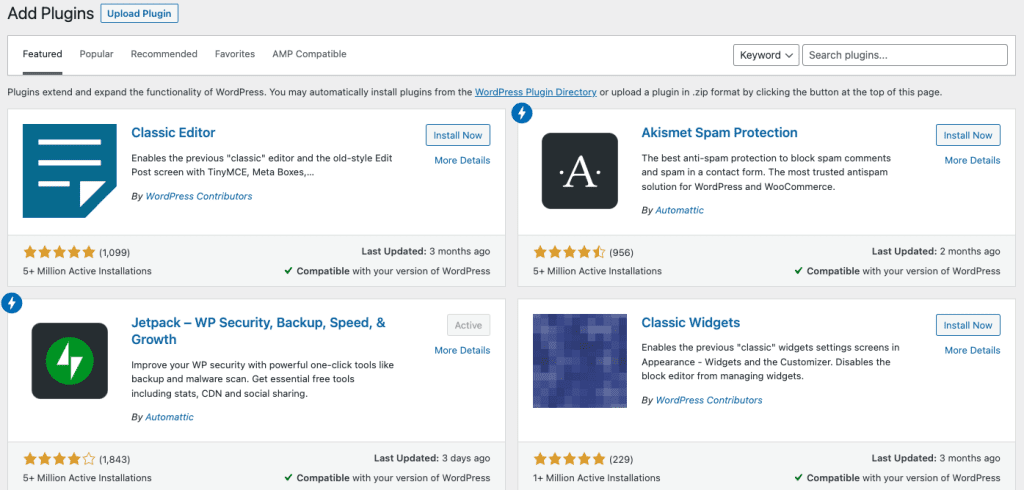
Regularly update your plugins to ensure optimal performance, security, and compatibility with the latest WordPress version. In the WordPress dashboard, go to the “Plugins” section and check for available updates. Click on the “Update Now” link to update individual plugins or use the “Update Plugins” button to update all installed plugins simultaneously.
Timely updates are crucial for maintaining a secure and well-functioning website, as developers release updates to address vulnerabilities, improve features, and enhance overall performance. By strategically selecting, installing, and maintaining plugins, you can extend the functionality of your WordPress website while maintaining a streamlined and efficient digital platform.
WordPress Plugins Recommendations
WordPress plugins offer a vast array of functionalities that can enhance and optimize your website in various ways. One essential category is SEO plugins, and a standout example is Yoast SEO. This plugin provides powerful tools to optimize your content for search engines, offering features such as content analysis, meta-tag customization, and XML sitemap generation. Yoast SEO helps improve your site’s visibility on search engine results pages and provides valuable insights to enhance your overall SEO strategy.
For security, Wordfence Security is a widely used plugin that provides robust protection against threats such as malware, phishing, and hacking attempts. It includes a firewall, malware scanner, and login attempt monitoring to fortify your website’s defences. With features like real-time threat intelligence and two-factor authentication, Wordfence Security is an excellent choice for safeguarding your WordPress site.
For performance optimization, W3 Total Cache is a popular plugin that helps improve your website’s speed and user experience. By caching content, compressing files, and integrating with content delivery networks (CDNs), W3 Total Cache minimizes page load times, a critical factor for retaining visitors and improving search engine rankings.
Adding social media functionality to your website is made easy with plugins like Shared Counts. This plugin allows you to integrate customizable social share buttons, track social sharing metrics, and encourage social engagement directly from your WordPress posts and pages. It supports various social media platforms and provides flexibility in design, making it a valuable tool for boosting your content’s reach and audience engagement.
Add eCommerce Feature to Your WordPress Website with WooCommerce
Integrating e-commerce functionality into your WordPress website can be efficiently achieved through the use of WooCommerce, a powerful and user-friendly plugin specifically designed for online stores. To get started, navigate to your WordPress dashboard, click on “Plugins,” and then select “Add New.” In the search bar, type “WooCommerce” and click “Install Now” once the WooCommerce plugin appears. After installation, activate the plugin to initiate the setup wizard.
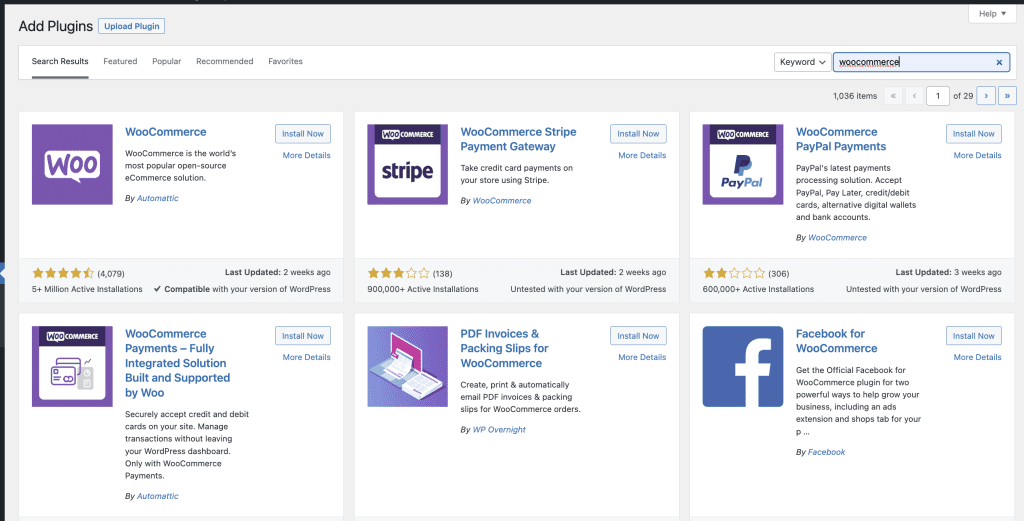
The WooCommerce setup wizard will guide you through the initial configuration process. You’ll be prompted to enter essential information, such as your store location, currency, and the types of products you plan to sell. Set up your payment methods, which may include popular options like PayPal or Stripe, and configure shipping methods based on your business requirements. WooCommerce offers extensive customization options, allowing you to tailor the plugin to match your specific needs.
Now that your basic settings are configured, proceed to add products to your online store. From the WordPress dashboard, navigate to “Products” and click on “Add Product.” Fill in the necessary details, including the product name, description, price, and images. You can also assign categories and tags to organize your products effectively. WooCommerce supports various product types, including physical goods, digital downloads, and even subscription-based services. Utilize these options based on the nature of your business.
Enhance the visual appeal and functionality of your e-commerce store by selecting a compatible WooCommerce theme. Many WordPress themes are specifically designed to integrate seamlessly with WooCommerce, providing a cohesive and professional appearance for your online shop. Once your store is set up, regularly monitor its performance using WooCommerce analytics. This allows you to track sales, customer behaviour, and inventory levels. WooCommerce’s user-friendly interface, extensive documentation, and active community support make it an excellent choice for adding e-commerce capabilities to your WordPress website.
Launch and Promote Your WordPress Website
Launching and promoting your WordPress website is a crucial step in reaching a wider audience and generating more traffic. Start by ensuring that your website is optimized for search engines (SEO). Use SEO plugins like Yoast SEO to optimize on-page elements, such as meta titles, descriptions, and headers. This approach improves your website’s visibility in search engine results, making it more likely for users to discover your content organically.
Utilize social media platforms to promote your WordPress website and engage with your audience. You may share your content across various social media channels, tailor your messaging to each platform, and encourage your followers to share your content.
Social media plugins can be integrated into your website, allowing visitors to easily share your posts. Engaging with your audience on social media fosters a sense of community and increases the likelihood that your content will be shared, leading to greater visibility and traffic.
Also, consider implementing an email marketing strategy to reach your audience directly. You may use plugins like Mailchimp or GetResponse to collect email addresses and send regular newsletters or updates. Besides, you can also offer incentives such as exclusive content, discounts, or free resources to encourage visitors to subscribe.
In addition, you may also collaborate with other websites and influencers in your niche to expand your reach. Guest posting, partnerships, or co-promotions can introduce your website to a new audience. Connect with influencers who align with your content and seek opportunities for collaboration. This cross-promotional approach leverages existing audiences to drive traffic to your website.
Consistently monitor your website analytics using tools like Google Analytics to assess the effectiveness of your promotion strategies and make data-driven adjustments for ongoing success.
Final Thoughts: A Practical Guide on How To Create WordPress Website on Bluehost
The journey to create your WordPress website on Bluehost has been a fulfilling exploration into the dynamic world of online presence. As you wrap up the final touches on your digital masterpiece, reflect on the incredible strides you’ve taken—from selecting the perfect domain name to customizing the layout and functionality that aligns with your vision. Bluehost’s reliable hosting services have been providing a stable foundation for your website to thrive.
Your WordPress website is more than just a collection of pages on the internet. Instead, it’s an extension of your ideas, your brand, and your aspirations. With the user-friendly features of WordPress and the dependable support of Bluehost, you’ve empowered yourself to venture into the online realm with confidence.
As you launch your website into the vast expanse of the web, keep in mind that this is just the beginning. Regularly update your content, engage with your audience, and stay informed about the latest trends in web development. The digital landscape is ever-evolving, and your website should evolve with it.




